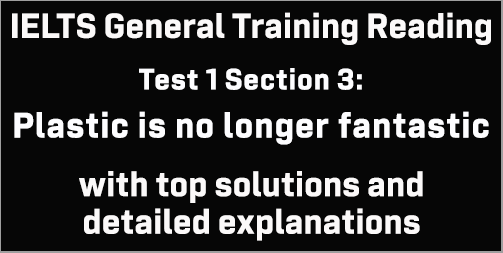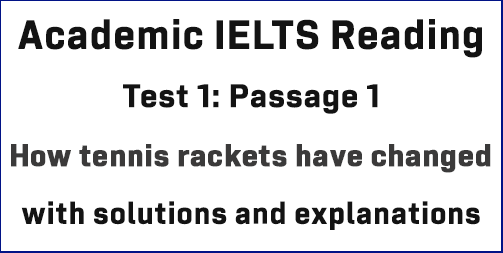IELTS General Training Reading: Test 1 Section 3; Plastic is no longer fantastic; with top solutions and best explanations
This General Training IELTS Reading post focuses on solutions to IELTS Reading Test 1 Section 3 which has a passage titled ‘Plastic is no longer fantastic’. This is a targeted post for GT IELTS candidates who have big problems finding and understanding Reading Answers in the GT module. This post can guide you to the best to understand every Reading answer without much trouble. Finding out IELTS Reading answers is a steady process, and this post will assist you in this respect.
Test 1 Section 3: Questions 28-40
The headline of the passage: Plastic is no longer fantastic
Questions 28-34: List of headings
[In this question type, IELTS candidates are provided with a list of headings, usually identified with lower-case Roman numerals (i, ii, iii, etc,). A heading will refer to the main idea of the paragraph or section of the text. Candidates must find out the equivalent heading to the correct paragraphs or sections, which are marked with alphabets A, B, C, and so forth. Candidates need to write the appropriate Roman numerals in the boxes on their answer sheets. There will always be two or three more headings than there are paragraphs or sections. So, some of the headings will not be used. It is also likely that some paragraphs or sections may not be included in the task. Generally, the first paragraph is an example paragraph that will be done for the candidates for their understanding of the task.
TIPS: Skimming is the best reading technique. You need not understand every word here. Just try to gather the gist of the sentences. That’s all. Read quickly and don’t stop until you finish each sentence.]
Question 28: Paragraph A
In section A, the first few lines talk about Carlos Ferrando’s experience of visiting a museum and watching a piece of artwork about plastic waste. Then, in the final lines, the writer says, “ .. . .. .. . The artwork, designed to raise public awareness, left Ferrando angry – and fuelled with entrepreneurial ideas.”
Here, left Ferrando angry = it was a very disturbing experience for Ferrando,
So, the answer is: vi (A disturbing experience)
Question 29: Paragraph B
Let’s read lines 1-3 of Paragraph B. The author of the text says here, “Ferrando runs a Spanish-based design company, Closca, that produces an ingenious foldable bicycle helmet. But he has now also designed a stylish glass water bottle with a stretchy silicone strap and magnetic closure mechanism. .. .. .”
Here, produces an ingenious foldable bicycle helmet & he has now also designed a stylish glass water bottle = two inventions,
If you read further inside this paragraph, you will find some physical details of both products.
So, the answer is: iv (Two inventions and some physical details)
Question 30: Paragraph C
Let’s read lines 1-2 of Paragraph C. The author of the passage says, “The intention is to persuade people to stop buying water in plastic bottles, thus saving consumers money and reducing the plastic waste piling up in our oceans. . .. .. . .”
Here, The intention = the reasons, saving consumers money and reducing the plastic waste piling up in our oceans = reasons for the need of Ferrando’s product,
So, the answer is: ii (The reasons why Ferrando’s product is needed)
Question 31: Paragraph D
To find an answer to this question, we must skim-read paragraph D. In lines 2-6, the writer explains, “ . .. .. .. Three decades ago, conspicuous consumption – the purchase of luxuries, such as handbags, shoes, cars, etc. on a lavish scale – heightened people’s social status. Indeed, the closing decades of the 20th century were a time when it seemed that anything could be turned into a commodity. Hence the fact that water became a consumer item, sold in plastic bottles, instead of just emerging, for free, from a tap.”
Here, Three decades ago & the closing decades of the 20th century were a time = looking back,
it seemed that anything could be turned into a commodity. Hence the fact that water became a consumer item, sold in plastic bottles = why water was bottled,
So, the answer is: viii (Looking back at why water was bottled)
Question 32: Paragraph E
In Paragraph E, take a look at lines 6-9. The writer says here, “ . .. . Some teenagers currently think that these stainless-steel vacuum-insulated water bottles that are coming back onto the market are ultra ‘cool’; never mind the fact that they feel oddly out-of-date to anyone over the age of 40 or that teenagers in the 1970s would have avoided ever being seen with one.”
Here, we can clearly see that one generation (the current teenagers) thinks that stainless-steel vacuum-insulated water bottles are ‘cool’ while the other generation (anyone over the age of 40) thinks that stainless-steel vacuum-insulated water bottles are ‘out-of-date’.
So, the answer is: v (The contrasting views of different generations)
Question 33: Paragraph F
In Paragraph F, have a look at lines 3-7, “ . .. .. . . it can be very hard for any design entrepreneur to really take off in the global mass market, though not as hard as it might have been in the past. If an entrepreneur had wanted to fund a smart invention a few decades ago, he or she would have had to either raise a bank loan, borrow money from a family member or use a credit card. Things have moved on slightly since then.”
Here, though not as hard as it might have been in the past. = The past was the time when opportunities were limited to raise a fund,
So, the answer is: i (A time when opportunities were limited)
Question 34: Paragraph G
In Paragraph G, take a close look at lines 10-12, “ . .. . Using this approach, none of the donors has a stake in his idea, nor does he have any debt. Instead, it is almost a pre-sale of the product, in a manner that tests demand in advance and creates a potential crowd of enthusiasts. . .. .”
Here, none of the donors has a stake in his idea, nor does he have any debt = A no-risk solution,
So, the answer is: iii (A no-risk solution)
Questions 35-37: Multiple-choice questions
[This type of question asks you to choose a suitable answer from the options using the knowledge you gained from the passage. This question type generally follows a sequence. So, scanning skill is effective here.]
Question 35: What does Ferrando say about his glass water bottle?
Keywords for this answer: What, Ferrando, say about, glass water bottle,
In paragraph C, in lines 6-8, Ferrando says, “ . . .. .. .. ‘We are trying to create a sense that being environmentally sophisticated is a status symbol,’ he adds. ‘We want people to clip their bottles onto what they are wearing, to show that they are recycling – and to look cool.’ ”
Here, to show that they are recycling – and to look cool = he wants people to be proud to show it,
So, the answer is: D (He wants people to be proud to show it.)
Question 36: What does the writer find fascinating about Ferrando’s story?
Keywords for this question: What, the writer, find fascinating, about Ferrando’s story,
To find an answer to this question, we have to read paragraph D and the opening of paragraph E, as the writer explains here, “Ferrando’s story is fascinating because it seems like an indicator of something unexpected. Three decades ago, conspicuous consumption – the purchase of luxuries, such as handbags, shoes, cars, etc. on a lavish scale – heightened people’s social status. Indeed, the closing decades of the 20th century were a time when it seemed that anything could be turned into a commodity. Hence the fact that water became a consumer item, sold in plastic bottles, instead of just emerging, for free, from a tap.”
These lines suggest that three decades ago people’s social status was based on the purchase of luxuries. So, using a plastic water bottle was also a symbol of status.
Then, in paragraph E, the first few lines say, “Today, though, conspicuous extravagance no longer seems desirable among consumers. Now, recycling is fashionable – as is cycling rather than driving. Plastic water bottles have become so common that they do not command status; . .. . .. .. ”
These lines suggest that at present, however, people’s attitude has changed regarding buying things for social status; and nowadays anything can be a commodity; and using plastic water bottles have so common that it doesn’t hold any social status anymore.
So, the answer is: D (the change it is revealing in people’s attitudes)
Question 37: What does the writer suggest about Closca’s bike helmet?
Keywords for this question: What, the writer, suggest, about, Closca’s bike helmet,
In the opening of paragraph F, the writer says, “It is uncertain whether Clesca will succeed in its goal. Although its foldable bike helmet is available in some outlets in New York, including the Museum of Modern Art, . . .”
Here, foldable bike helmet = functional value,
available in .. . .. . the Museum of Modern Art = artistic value,
So, the answer is: A (It has both functional and artistic value.)
Questions 37-40: Summary completion
[In this kind of question candidates are given a summary for one, two, or three paragraphs with some fill-in-the-blanks questions. Candidates need to find out the related paragraphs by correctly studying the keywords from the questions. Then, they should follow the steps of finding answers to fill in the gaps.]
Title of the summary: Funding a smart invention
Question 38: Thirty years ago, the methods used by creators to fund their projects involved getting money from the bank or from someone in the ___________.
Keywords for this question: Thirty years ago, methods used by creators, fund their projects, getting money from the bank, from someone in the,
In lines 5-7 of Paragraph F, the writer mentions, “ . .. If an entrepreneur had wanted to fund a smart invention a few decades ago, he or she would have had to either raise a bank loan, borrow money from a family member or use a credit card. . … .. . ..”
Here, an entrepreneur = creators,
a few decades ago = Thirty years ago,
raise a bank loan = getting money from the bank,
from a family member = from someone in the family,
So, the answer is: family
Question 39: In order to get immediate funding, the method Ferrando took was to use a well-known ____________ to advertise his product and request financial support.
Keywords for this question: to get immediate funding, method Ferrando took, use a well-known, to advertise his product, request financial support,
In Paragraph G, the answer lies in lines 4-5. Here, the writer mentions, “ . .. Ferrando posted details about his water-bottle venture on a large, recognised platform for funding creative projects.”
Here, posted details about his water-bottle venture = use .. … . to advertise his product,
recognised = well-known,
for funding = request financial support,
So, the answer is: platform
Question 40: In addition, Ferrando advised his donors that his company would create bottles in two colours, followed by a __________ bottle once they had received a more significant amount.
Keywords for this question: In addition, Ferrando advised his donors would create bottles in two colours, followed by a, bottle, once they had received, more significant amount,
Again, in paragraph G, in lines 8-10, the writer explains, “ … . . .. . If he received the funds, he stated that the company would produce bottles in grey and white; if $60,000 was raised, a multicoloured one would be made. … .. . . .”
Here, grey and white = two colours,
if $60,000 was raised = if Ferrando’s company received a more significant amount,
So, the answer is: multicoloured/ multi-coloured/ multi-colored
Click here for solutions to GT Test 1 Section 1: Helping pupils & Ripton Festival
Click here for solutions to GT Test 1 Section 2: Reducing injuries & Good customer service




Its really good information for me and those people who takes interest in spoken English or languages. Thank you very much for share this amazing blog.